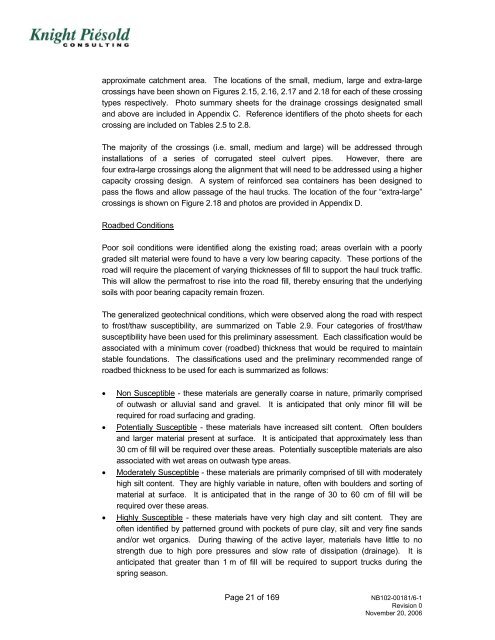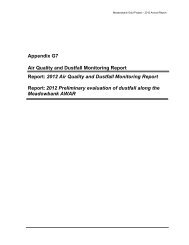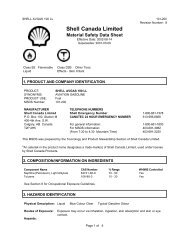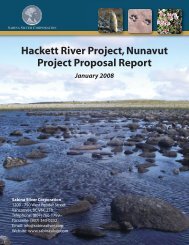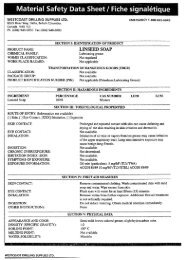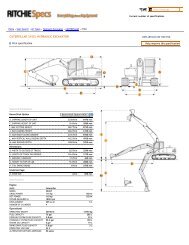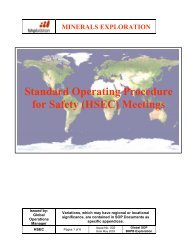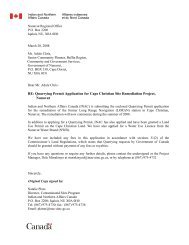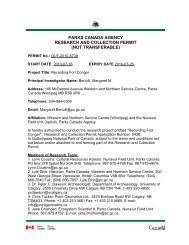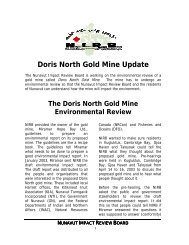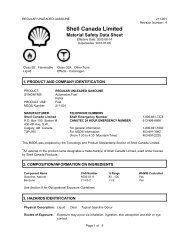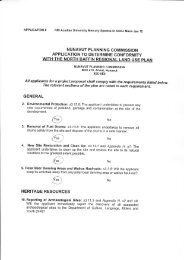061211-Environmental Screening Report-IMAE.pdf - nirb
061211-Environmental Screening Report-IMAE.pdf - nirb
061211-Environmental Screening Report-IMAE.pdf - nirb
You also want an ePaper? Increase the reach of your titles
YUMPU automatically turns print PDFs into web optimized ePapers that Google loves.
approximate catchment area. The locations of the small, medium, large and extra-largecrossings have been shown on Figures 2.15, 2.16, 2.17 and 2.18 for each of these crossingtypes respectively. Photo summary sheets for the drainage crossings designated smalland above are included in Appendix C. Reference identifiers of the photo sheets for eachcrossing are included on Tables 2.5 to 2.8.The majority of the crossings (i.e. small, medium and large) will be addressed throughinstallations of a series of corrugated steel culvert pipes. However, there arefour extra-large crossings along the alignment that will need to be addressed using a highercapacity crossing design. A system of reinforced sea containers has been designed topass the flows and allow passage of the haul trucks. The location of the four “extra-large”crossings is shown on Figure 2.18 and photos are provided in Appendix D.Roadbed ConditionsPoor soil conditions were identified along the existing road; areas overlain with a poorlygraded silt material were found to have a very low bearing capacity. These portions of theroad will require the placement of varying thicknesses of fill to support the haul truck traffic.This will allow the permafrost to rise into the road fill, thereby ensuring that the underlyingsoils with poor bearing capacity remain frozen.The generalized geotechnical conditions, which were observed along the road with respectto frost/thaw susceptibility, are summarized on Table 2.9. Four categories of frost/thawsusceptibility have been used for this preliminary assessment. Each classification would beassociated with a minimum cover (roadbed) thickness that would be required to maintainstable foundations. The classifications used and the preliminary recommended range ofroadbed thickness to be used for each is summarized as follows:• Non Susceptible - these materials are generally coarse in nature, primarily comprisedof outwash or alluvial sand and gravel. It is anticipated that only minor fill will berequired for road surfacing and grading.• Potentially Susceptible - these materials have increased silt content. Often bouldersand larger material present at surface. It is anticipated that approximately less than30 cm of fill will be required over these areas. Potentially susceptible materials are alsoassociated with wet areas on outwash type areas.• Moderately Susceptible - these materials are primarily comprised of till with moderatelyhigh silt content. They are highly variable in nature, often with boulders and sorting ofmaterial at surface. It is anticipated that in the range of 30 to 60 cm of fill will berequired over these areas.• Highly Susceptible - these materials have very high clay and silt content. They areoften identified by patterned ground with pockets of pure clay, silt and very fine sandsand/or wet organics. During thawing of the active layer, materials have little to nostrength due to high pore pressures and slow rate of dissipation (drainage). It isanticipated that greater than 1 m of fill will be required to support trucks during thespring season.Page 21 of 169NB102-00181/6-1Revision 0November 20, 2006


